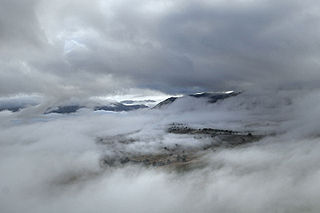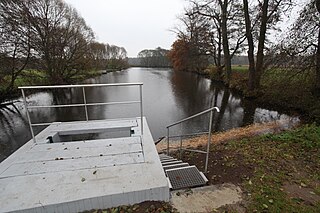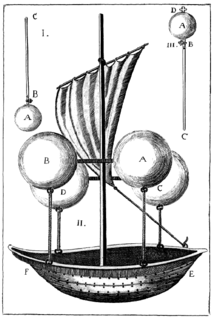A viscometer is an instrument used to measure the viscosity of a fluid. For liquids with viscosities which vary with flow conditions, an instrument called a rheometer is used. Thus, a rheometer can be considered as a special type of viscometer. Viscometers only measure under one flow condition.

An aerosol is a suspension of fine solid particles or liquid droplets, in air or another gas. Aerosols can be natural or anthropogenic. Examples of natural aerosols are fog, dust, forest exudates and geyser steam. Examples of anthropogenic aerosols are haze, particulate air pollutants and smoke. The liquid or solid particles have diameters typically <1 μm; larger particles with a significant settling speed make the mixture a suspension, but the distinction is not clear-cut. In general conversation, aerosol usually refers to an aerosol spray that delivers a consumer product from a can or similar container. Other technological applications of aerosols include dispersal of pesticides, medical treatment of respiratory illnesses, and combustion technology. Diseases can also spread by means of small droplets in the breath, also called aerosols.
Hemodynamics or haemodynamics are the dynamics of blood flow. The circulatory system is controlled by homeostatic mechanisms, such as hydraulic circuits are controlled by control systems. Hemodynamic response continuously monitors and adjusts to conditions in the body and its environment. Thus hemodynamics explains the physical laws that govern the flow of blood in the blood vessels.

Settling is the process by which particulates settle to the bottom of a liquid and form a sediment. Particles that experience a force, either due to gravity or due to centrifugal motion will tend to move in a uniform manner in the direction exerted by that force. For gravity settling, this means that the particles will tend to fall to the bottom of the vessel, forming a slurry at the vessel base.
In viscous fluid dynamics, the Archimedes number (Ar), named after the ancient Greek scientist Archimedes is used to determine the motion of fluids due to density differences. It is a dimensionless number, the ratio of gravitational forces to viscous forces and has the form:
The Knudsen number (Kn) is a dimensionless number defined as the ratio of the molecular mean free path length to a representative physical length scale. This length scale could be, for example, the radius of a body in a fluid. The number is named after Danish physicist Martin Knudsen (1871–1949).

Differential centrifugation is a common procedure in biochemistry and cell biology used to separate organelles and other sub-cellular particles on the basis of sedimentation rate. Although often applied in biological analysis, differential centrifugation is a general technique also suitable for crude purification of non-living suspended particles. In a typical case where differential centrifugation is used to analyze cell-biological phenomena, a tissue sample is first lysed to break the cell membranes and release the organelles and cytosol. The lysate is then subjected to repeated centrifugations, where particles that sediment sufficiently quickly at a given centrifugation force for a given time form a compact "pellet" at the bottom of the centrifugation tube. After each centrifugation, the supernatant is removed from the tube and re-centrifuged at an increased centrifugal force and/or time. Differential centrifugation is suitable for crude separations on the basis of sedimintation rate, but more fine grained purifications may be done on the basis of density through equilibrium density-gradient centrifugation.

A pressure vessel is a container designed to hold gases or liquids at a pressure substantially different from the ambient pressure.

Collision theory is a theory that was proposed independently by Max Trautz in 1916 and William Lewis in 1918. The collision theory states that when suitable particles of the reactant hit each other, only a certain fraction of the collisions cause any noticeable or significant chemical change; these successful changes are called successful collisions. The successful collisions must have enough energy, also known as activation energy, at the moment of impact to break the pre-existing bonds and form all new bonds. This results in the products of the reaction. Increasing the concentration of the reactant particles or raising the temperature - which brings about more collisions and hence more successful collisions - therefore increases the rate of a reaction.
In physics the Einstein relation is a previously unexpected connection revealed independently by William Sutherland in 1904, Albert Einstein in 1905, and by Marian Smoluchowski in 1906 in their works on Brownian motion. The more general form of the equation is

The Stokes number (Stk), named after George Gabriel Stokes, is a dimensionless number characterising the behavior of particles suspended in a fluid flow. The Stokes number is defined as the ratio of the characteristic time of a particle to a characteristic time of the flow or of an obstacle, or

In stellar physics, the Jeans instability causes the collapse of interstellar gas clouds and subsequent star formation, named after James Jeans. It occurs when the internal gas pressure is not strong enough to prevent gravitational collapse of a region filled with matter. For stability, the cloud must be in hydrostatic equilibrium, which in case of a spherical cloud translates to:
The Ohnesorge number (Oh) is a dimensionless number that relates the viscous forces to inertial and surface tension forces. The number was defined by Wolfgang von Ohnesorge in his 1936 doctoral thesis.
In nonideal fluid dynamics, the Hagen–Poiseuille equation, also known as the Hagen–Poiseuille law, Poiseuille law or Poiseuille equation, is a physical law that gives the pressure drop in an incompressible and Newtonian fluid in laminar flow flowing through a long cylindrical pipe of constant cross section. It can be successfully applied to air flow in lung alveoli, or the flow through a drinking straw or through a hypodermic needle. It was experimentally derived independently by Jean Léonard Marie Poiseuille in 1838 and Gotthilf Heinrich Ludwig Hagen, and published by Poiseuille in 1840–41 and 1846. The theoretical justification of the Poiseuille law was given by George Stokes in 1845.
In fluid dynamics, the Hadamard–Rybczynski equation gives the terminal velocity of slowly moving spherical bubble through an ambient fluid. It is named after Jacques Hadamard and Witold Rybczynski:

A vacuum airship, also known as a vacuum balloon, is a hypothetical airship that is evacuated rather than filled with a lighter-than-air gas such as hydrogen or helium. First proposed by Italian Jesuit priest Francesco Lana de Terzi in 1670, the vacuum balloon would be the ultimate expression of lifting power per volume displaced.

The Reynolds number is the ratio between the inertial forces in a fluid and the viscous forces. A fluid in motion tends to behave as sheets or layers of infinitely small thicknesses sliding relative to each other. The viscosity of a fluid is the resistance to flow, which in turn translates as resistance to shear between the layers. The inertia (momentum) of the fluid is a dynamic function of its mass and speed, or resistance to a change in motion, which works to create shear between the fluid layers. This shear is created as a fluid encounters viscous resistance from an outside obstacle, such as the inner wall of a pipe, where flow is slowed by drag against the surface while remaining mostly unimpeded near the center of the pipe. For any given fluid, as flow rate increases, at a certain point the inertial forces begin to overcome the viscous forces; the smoothly-sliding layers of the fluid begin to roll past each other, and rough, turbulent flow results. Reynolds number is used to predict both where and at what scale in the flow this transition will happen for any given fluid in any given flow situation.
In fluid dynamics, the Basset–Boussinesq–Oseen equation describes the motion of – and forces on – a small particle in unsteady flow at low Reynolds numbers. The equation is named after Joseph Valentin Boussinesq, Alfred Barnard Basset and Carl Wilhelm Oseen.













